Fall Color - Coming To A Tree Near You...
It's about that time of the year again to gaze upon Mother Nature's fall foliage, which is really starting to show up. By now, you've probably noticed a few eager trees changing color pretty rapidly, some of this could be due to a little stress, but it's not uncommon to start seeing some changes at this time of the year.
Minnesota Fall Color Update
According the MN DNR, much of the state is already starting to see hints of fall color, however, there are pockets of 25%-50% color across parts of Central, Western and Northwestern Minnesota!
Typical Fall Color Peak in Minnesota
Here are the typical fall color peak times across the state of Minnesota and note that areas along the northern tier of the state usually see their peak toward the 2nd half of September. However, peak color usually doesn't arrive in central Minnesota until October, but we're getting close.
Typical Fall Color Times Across the Country
Here are the typical fall color peak times across the country, which suggests that much of the peak across the northern half of the nation usually wraps up through the month of October.
La Nina Watch Issued by NOAA
Uh oh... grease up your shovels... get that wood pile ready... we cold be in for a colder and snowier winter! According to NOAA, the water temperature in the Eastern Pacific is beginning to cool and has been over the last couple of months. This trend may continue, which could lead right into a La Nina Winter! In fact, NOAA has issued a La Nina watch for the fall and winter 2017-18!!
"There is an increasing chance (~55-60%) of La Niña during the Northern Hemisphere fall and winter 2017-2018."

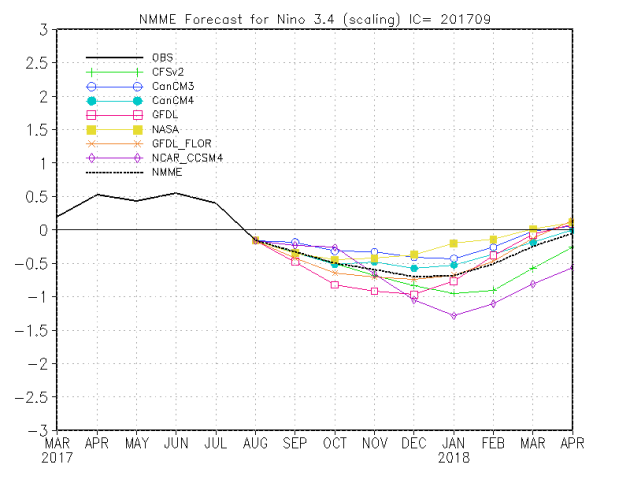
"In mid-September 2017, the tropical Pacific remained in an ENSO-neutral state, although SSTs in the east-central tropical Pacific have cooled to near the threshold for La Niña while the atmosphere continues to maintain largely ENSO-neutral patterns. The collection of latest ENSO prediction models indicates coolish ENSO-neutral or weak La Niña as two possible scenarios during Northern Hemisphere fall and winter. The official CPC/IRI outlook slightly favors La Niña development, and carries a La Niña watch."
Historically Speaking
**El Niño and La Niña events tend to develop during the period Apr-Jun and they
Tend to reach their maximum strength during October - February
**Typically persist for 9-12 months, though occasionally persisting for up to 2 years
**Typically recur every 2 to 7 years
Tend to reach their maximum strength during October - February
**Typically persist for 9-12 months, though occasionally persisting for up to 2 years
**Typically recur every 2 to 7 years
So what does this mean? Well, if La Nina does develop, the northern tier of the nation could be colder and snowier this upcoming season, while drier and warmer conditions may be found across the southern tier of the nation...
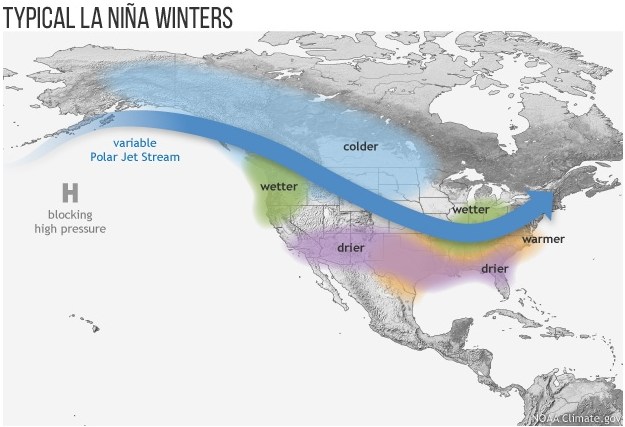 _________________________________________________________________
_________________________________________________________________
Tracking JOSE
We're still tracking JOSE in the Atlantic basin and unfortunately, JOSE could become more of a story as we head into the week ahead. According to NOAA's NHC, JOSE was a category 1 hurricane with sustained winds of 80mph early Saturday with a track that looks to take it precariously close to the East Coast into the week ahead.
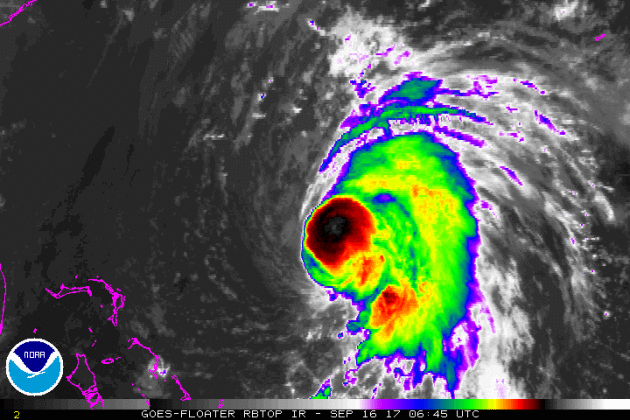
Here's the official track from NOAA's NHC, which show the storm generally lifting north-northeast through the week ahead, but note the "cone of uncertainty" fanning out over the next several days. This means that there is still some uncertainty on where JOSE will actually track and could actually be a little closer to the East Coast, which would mean bigger impacts for the Northeast... Stay tuned!

Here's the GFS (American Model) of JOSE as it nears the Northeast Coast through the early week time frame. While this particular model doesn't show the center of the storm making landfall in the Northeast, we will likely still have big impacts across the region and especially along the coast. Keep in mind that it is still too early to tell exactly where the storm will track, it will be important to keep an eye on weather forecasts over the next few days.
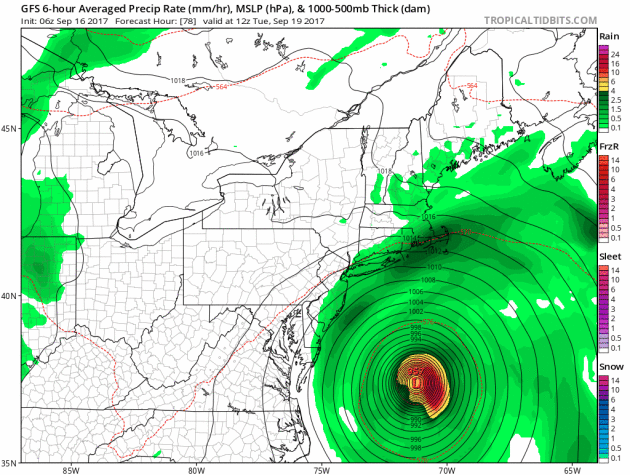
Tracking JOSE - ECMWF (European Model)
Just for comparison, here is the ECMWF model, which shows the placement of the storm at 7am Wednesday. While the center of the storm looks to stay offshore, we will likely still have strong winds, high surf and potentially heavy rains along the coast from Long Island to the Cape and for a few locations inland. Again, it's too early to tell where the storm will track exactly, but folks in these areas need to pay attention to weather forecast over the days ahead.
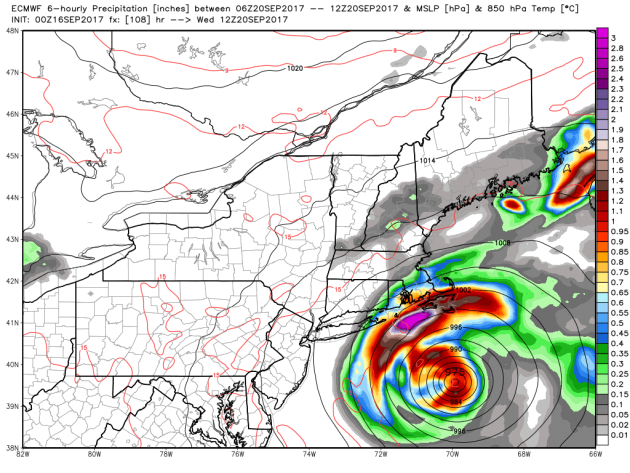
Tracking JOSE - Strongest Wind Gusts AM Wednesday
Here's a quick look at what kind of wind gusts we could be dealing with by 7AM Wednesday. Note that some spots along the coast could be seeing up to 50mph+ wind gusts, while widespread tropical storm force (39mph+) wind gusts could be possible for a number of inland locations.

Tracking JOSE - How Much Rain?
Here's the rainfall potential through the middle part of the week, which suggests fairly heavy rain along the coast as JOSE slides through the region. Note that some locations from Long Island to the Cape could see up to 2" to 4"+ rainfall. Again, keep in mind that the rain fall potential will be heavily dictated by the track of the storm. If the storm tracks farther west and closer to the coast, we can expect heavy rain & wind across a much wider area, but if the storm shifts east, we can expect less rain and not as strong of winds. Stay tuned...
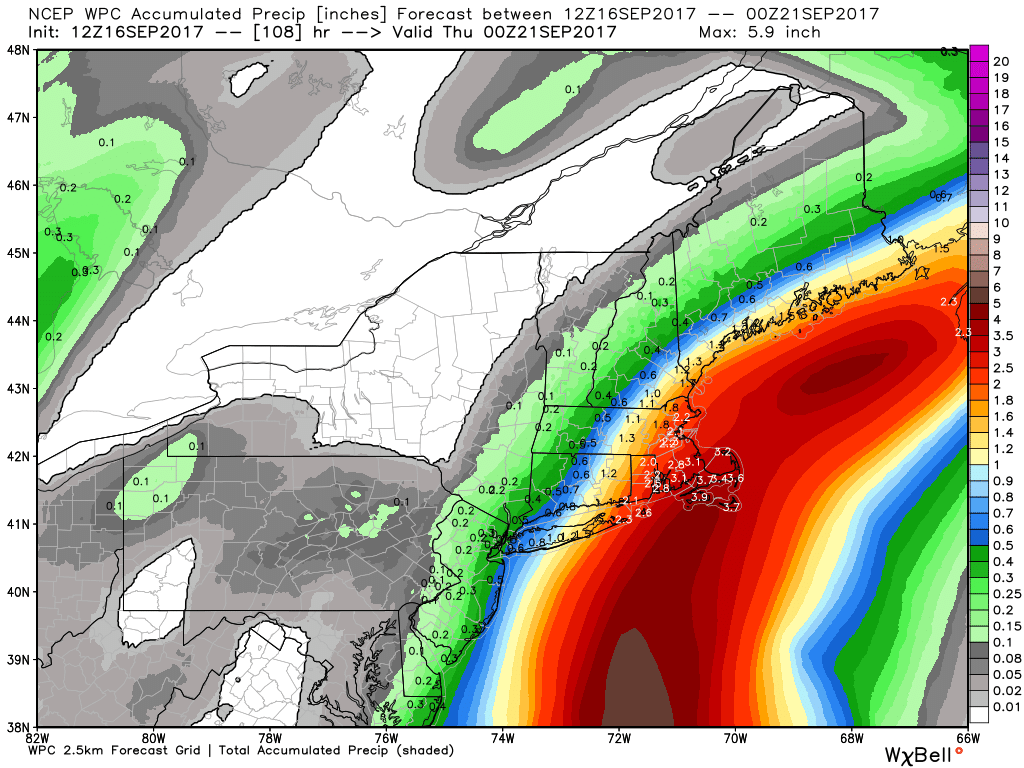
________________________________________________________
Atlantic Outlook Next 5 Days
Here's the Atlantic outlook over the next few days, which shows that the basin remains very active as we head into 3rd week of September. While JOSE remains one of our top stories, we're also tracking LEE and MARIA.
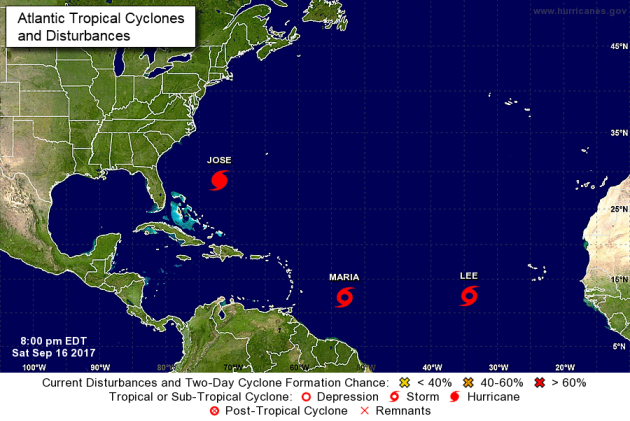
Tracking LEE
Here's NOAA's NHC forecast for LEE, which at this point doesn't appear to be all that impressive as it tracks northwest over open water into early next week. Stay tuned...
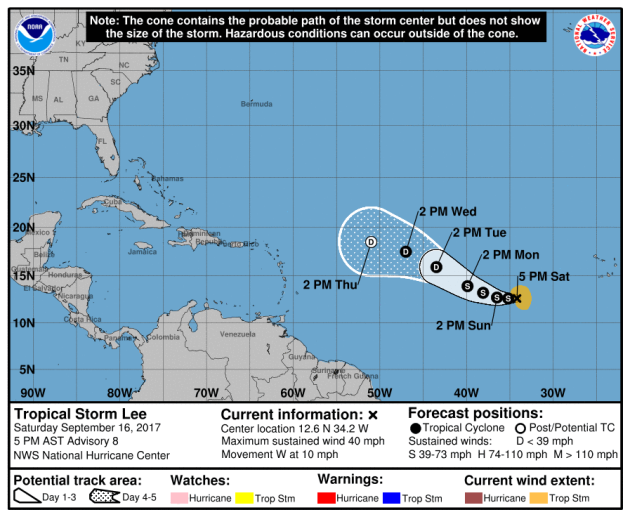
Tracking MARIA
Alright, this system is a little more concerning as it seems to be taking a fairly similar track as IRMA did toward the northern Lesser Antilles and toward Puerto Rico once again. Note that Tropical Storm Watches have already been issued for parts of the Lesser Antilles as this storm approaches and likely intensifies. NOAA's NHC has this storm gaining hurricane strength just before it reaches the islands. Ugh...

Active in the Eastern Pacific
While things remain active in the Atlantic Basin, things in the Eastern Pacific are still quite active as well. According to NOAA's NHC, there are still 2 storms in place with NORMA and Tropical Storm Otis
.png)
Here's a look at Hurricane NORMA, which was a category 1 hurricane with sustained winds of 75mph as of early Saturday.
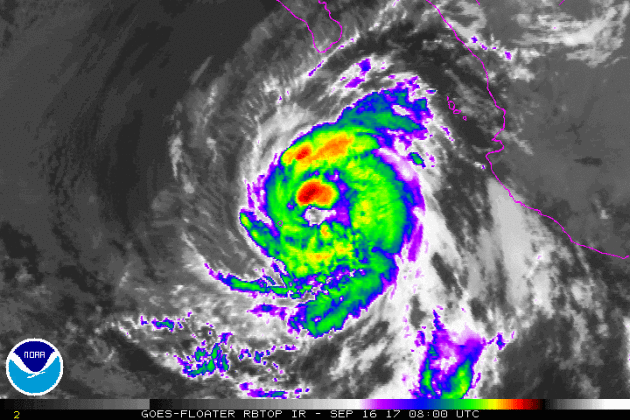
Tracking NORMA
The official track for NORMA shows this storm staying as a hurricane through the weekend before weakening into a tropical storm as it nears the southern tip of Baja California, where tropical storm watches and warnings have been posted.
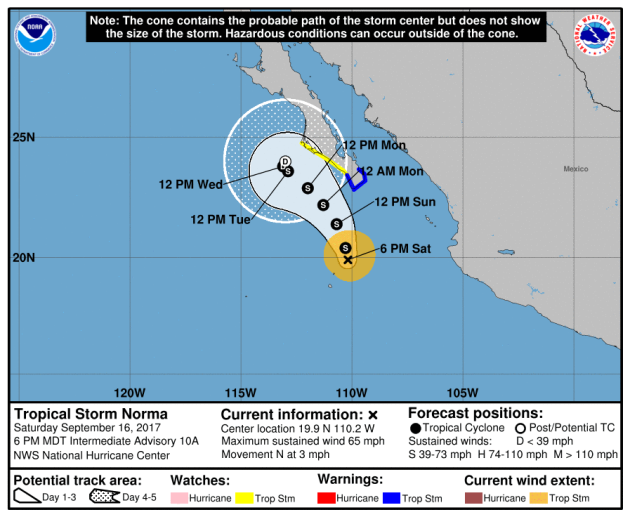
The good news is that this storm shouldn't pose much of a problem or threat in the Eastern Pacific and is slowly and aimlessly wanders west. Goodbye...
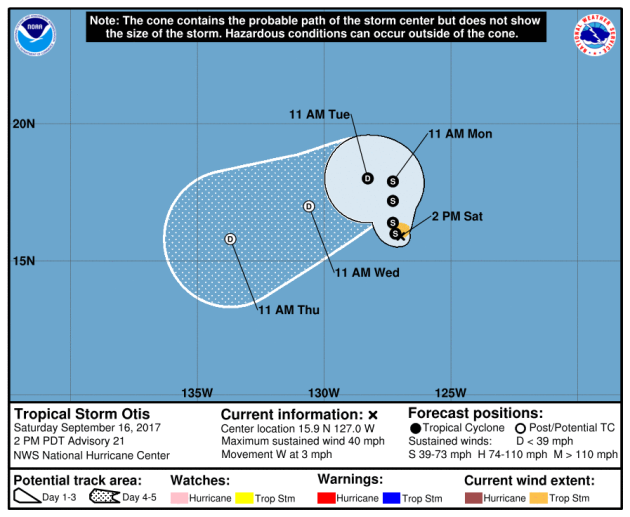
September 10th - Official Peak of the Atlantic Hurricane Season
It's only fitting that on the official peak of the Atlantic Hurricane Season (September 10th), Hurricane IRMA made landfall with the Lower Florida Keys at 9:10am on Sunday, September 10th. Note that the season, on average, remains pretty active through the rest of September and throughout October, but falls dramatically into November. Keep in mind that the official end of the Atlantic Hurricane Season is November 30th.
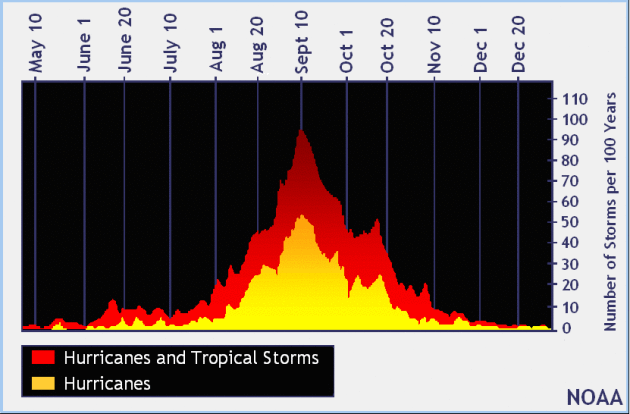
PRELIMINARY 2017 Tornado Map
It certainly has been a fairly active first half of 2017 with 1344 preliminary tornado reports through September 9th. Note that this is the most tornadoes through September 9th since 2011, when there were 1,782 reports. The map below shows the distribution of the tornadoes so far this year.
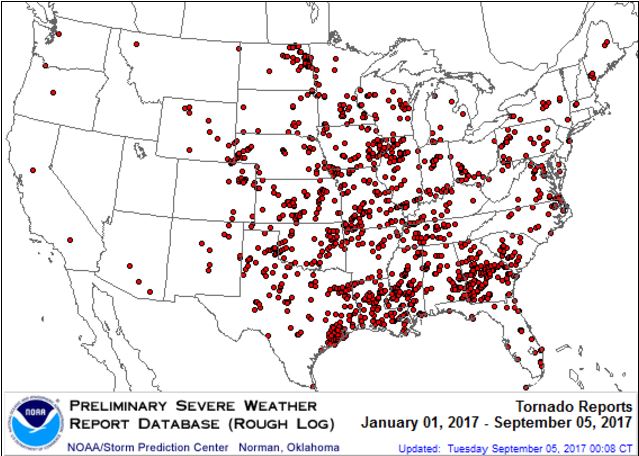 PRELIMINARY 2017 Tornado Count
PRELIMINARY 2017 Tornado Count
According to NOAA's SPC, the PRELIMINARY 2017 tornado count is 1366 (through September 15th). Note that is the most active year for tornadoes since 2011, when there were 1,782 tornadoes. Keep in mind there was a major tornado outbreak in the Gulf Coast region from April 25-28, 2011 that spawned nearly 500 tornadoes, some of which were deadly. That outbreak is known as the Super Outbreak of 2011 and has gone down in history as one of the biggest, costliest and one of the deadliest tornado outbreaks in history.

_____________________________________________________________________
According to NOAA's SPC, the PRELIMINARY 2017 tornado count is 1366 (through September 15th). Note that is the most active year for tornadoes since 2011, when there were 1,782 tornadoes. Keep in mind there was a major tornado outbreak in the Gulf Coast region from April 25-28, 2011 that spawned nearly 500 tornadoes, some of which were deadly. That outbreak is known as the Super Outbreak of 2011 and has gone down in history as one of the biggest, costliest and one of the deadliest tornado outbreaks in history.

_____________________________________________________________________
2.) Significant waves shifting north from coastal parts of the Outer Banks to New England, Mon-Wed, Sep 18-20.
3.) Heavy rain for portions of Long Island and southeast New England, Tue-Wed, Sep 19-20.
4.) Much below-normal temperatures for parts of the Pacific Northwest, Great Basin, and the northern and central Rockies, Mon-Fri, Sep 18-22.
5.) Periods of heavy snow for parts of the northern Rockies, Mon-Wed, Sep 18-20.
6.) Periods of heavy rain for parts of the Pacific Northwest, Mon-Wed, Sep 18-20.
7.) Severe weather for parts of the northern and central Great Plains, Tue, Sep 19.
8.) Flooding occurring or imminent across parts of Florida.
9.) Flooding possible across parts of the Florida Peninsula.
10.) A slight risk of much below-normal temperatures for parts of the western U.S., Sat-Sun, Sep 23-24.
11.) Severe drought across parts of the northern Rockies, northern and central Great Plains, Corn Belt, Minnesota, Rio Grande Valley, and Hawaii.
.png)
_________________________________________________________
"Better late than never as rainfall hits drought-stricken Montana"
"Precipitation fell in Montana this week with nearly three-quarters of the state in severe drought, bringing welcomed assistance to firefighting crews who've worked through a historically tough summer. In northeastern Montana, where exceptional drought covers 25 percent of the state, the moisture isn't enough to reverse crop losses this season. But ag producers are happy to see Mother Nature join the fight against wildfires. "We are thankful for any moisture we receive at this point, particularly for the fire danger relief," said Shelley Mills, Montana State University Extension Ag Agent for Valley County. "Tension has been high for all residents in this area due to the extreme fire danger we have been experiencing."According to the U.S. Drought Monitor, the entire state is experiencing less-than-normal moisture, with the vast majority in some level of drought."
See more from Billings Gazette HERE:
(Image Credit: Casey Page Via Billings Gazette)

See more from AgWeb HERE:

Rain Needed to End Drought
Exceptional and Extreme drought conditions are in place over parts of Montana and North and South Dakota due to several weeks/months of hot and dry weather. The image below suggests how much rain would be needed to end the drought, which suggests nearly 6" to 12" or more!
____________________________________________________________________
Chetco Bar Fire - 5 Miles Northeast of Brookings, OR
The Chetco Bar Fire near Brookings, Oregon is a very large wildfire in the Western US that started on Wednesday, July 12th by lightning and has grown to more than 188,000 acres! There are nearly 1,700 people working on this fire, which is 40% contained. The estimated containment date is set for Sunday, October 15th.
"Incident Summary: Chetco Bar Fire was reported on July 12, 2017. It is burning in the 2002 Biscuit Fire and 1987 Silver Fire scars located in the Kalmiopsis Wilderness, between Brookings, Oregon on the West and Cave Junction on the East. The area is comprised of mixed conifer and deciduous forest, brush and snags from the previous fires. The fire is burning in areas of fire scar and islands that were previously unburned. The combination of down, dead fuels with a newly cured grass makes the terrain quite hazardous for firefighters."
See more from Inciweb HERE:
(Close view fo smoke from the Indigo Fire, September 13. Snags from the Biscuit Fire are in the foreground. The fire is located 6 miles south of Bear Camp near the Josephine County line.)

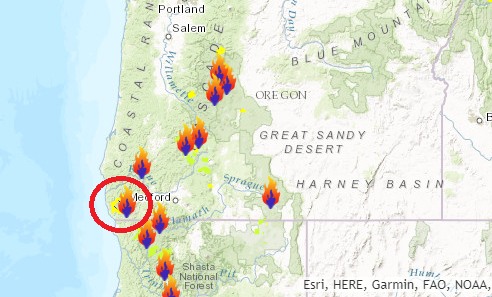 Diamond Creek Fire - Mazama, Washington
Diamond Creek Fire - Mazama, Washington
The Diamond Creek Fire near Mazama, Washington is a very large wildfire in the Western US that started on Sunday, July 23rd and has grown to more than 122,000 acres! There are nearly 215 people working on this fire, which is 30% contained. The estimated containment date is set for Sunday, October 15th.
"Fire Location: Diamond Creek Fire is burning within the Pasayten Wilderness and Eightmile drainage approximately 11 air miles north of Mazama, Washington. Smokejumpers responded to the fire within the first 1 1/2-2 hours of it being reported. However, due to extreme terrain, heavy dead and down timber, and critical fire weather conditions, the fire was unable to be contained on initial response. The fire crossed the Canadian Border on August 29."
See more from Inciweb HERE:
(A crew builds a handline through rocky topography south of Setting Sun Mountain)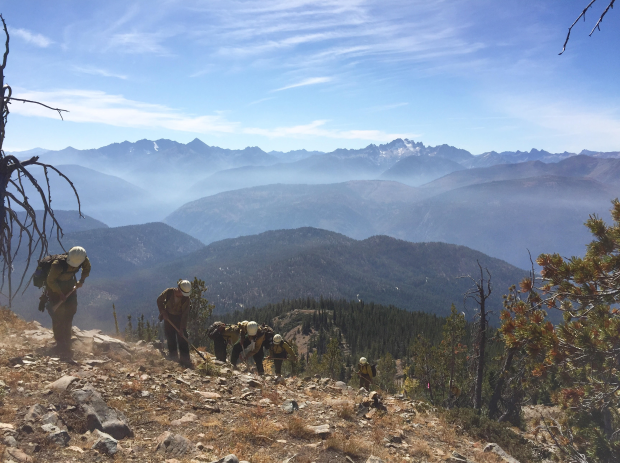
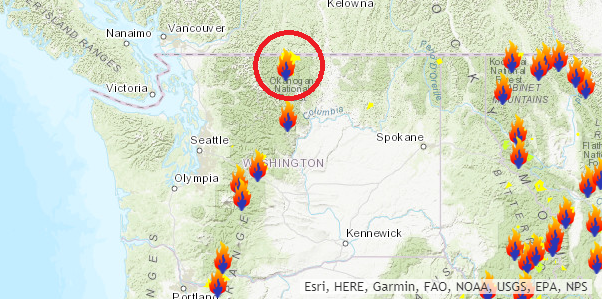 Ongoing Large Wildfires
Ongoing Large Wildfires
Here's a look at the current wildfire map across the country. Continued hot and dry weather has helped to spark several wildfires across the Western US. There have even been fires popping up in the Eastern U.S., two of the larger fires are burning in Florida.
Here's a list of all the current large wildfires from Inciweb:
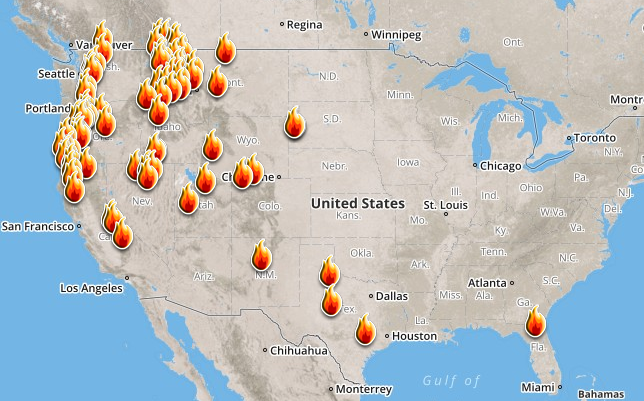

The Chetco Bar Fire near Brookings, Oregon is a very large wildfire in the Western US that started on Wednesday, July 12th by lightning and has grown to more than 188,000 acres! There are nearly 1,700 people working on this fire, which is 40% contained. The estimated containment date is set for Sunday, October 15th.
"Incident Summary: Chetco Bar Fire was reported on July 12, 2017. It is burning in the 2002 Biscuit Fire and 1987 Silver Fire scars located in the Kalmiopsis Wilderness, between Brookings, Oregon on the West and Cave Junction on the East. The area is comprised of mixed conifer and deciduous forest, brush and snags from the previous fires. The fire is burning in areas of fire scar and islands that were previously unburned. The combination of down, dead fuels with a newly cured grass makes the terrain quite hazardous for firefighters."
See more from Inciweb HERE:
(Close view fo smoke from the Indigo Fire, September 13. Snags from the Biscuit Fire are in the foreground. The fire is located 6 miles south of Bear Camp near the Josephine County line.)
 Diamond Creek Fire - Mazama, Washington
Diamond Creek Fire - Mazama, WashingtonThe Diamond Creek Fire near Mazama, Washington is a very large wildfire in the Western US that started on Sunday, July 23rd and has grown to more than 122,000 acres! There are nearly 215 people working on this fire, which is 30% contained. The estimated containment date is set for Sunday, October 15th.
"Fire Location: Diamond Creek Fire is burning within the Pasayten Wilderness and Eightmile drainage approximately 11 air miles north of Mazama, Washington. Smokejumpers responded to the fire within the first 1 1/2-2 hours of it being reported. However, due to extreme terrain, heavy dead and down timber, and critical fire weather conditions, the fire was unable to be contained on initial response. The fire crossed the Canadian Border on August 29."
See more from Inciweb HERE:
(A crew builds a handline through rocky topography south of Setting Sun Mountain)

Here's a look at the current wildfire map across the country. Continued hot and dry weather has helped to spark several wildfires across the Western US. There have even been fires popping up in the Eastern U.S., two of the larger fires are burning in Florida.
Here's a list of all the current large wildfires from Inciweb:
National Smoke Analysis
Here's the projected wildfire smoke concentration for midday Sunday, which suggests that smoke from wildfires burning across parts of Western Canada and the Western US could continue to linger around the Northwest and Midwest. There also appears a very high concentration of smoke across parts of the Northeast. If you are in these areas, air quality could be a little poor, but these areas may also be enjoying very interesting looking sunrises/sunsets, which tend to look hazy or reddish-orange.

_________________________________________________________________________
National Weather Outlook
Here's the weather outlook through the early part of the week, which shows a cool front sliding through the central part of the country. This will touch off scattered showers and storms, some of which could be a little on the strong side, but could also produce areas of locally heavy rainfall. Another front will move into the Pacific Northwest early next week, which will bring another round of much needed precipitation to areas there. It will also come with another surge of cooler air, which will help to bring another round of snow to the higher elevations. Also note JOSE, the tropical system in the Atlantic approaching the East Coast as we head into the early week time frame.
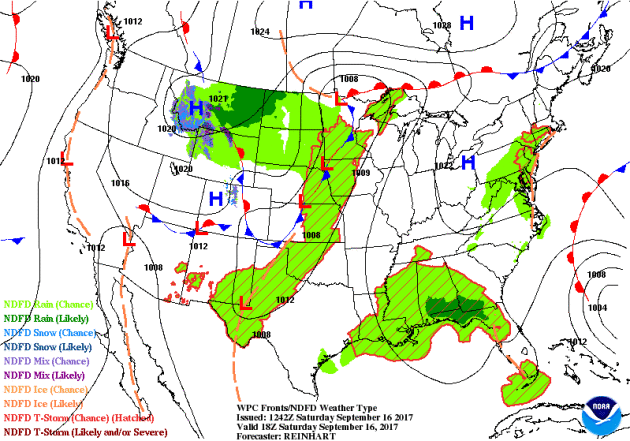
5 Day Precipitation Outlook
According to NOAA's WPC, the next several days could produce areas of locally heavy rainfall across parts of the Central and Northwestern US. It looks like we get into a much more progressive pattern, so there will be more moisture potential across the northern tier of the nation as we head into the next several days. Note that some in the Cascades could see up to 3" to 6"+ of liquid, some of while could fall in the form of snow in the higher elevations. Also note the heavy rain potential moving into the Northeast Coast, which would be associated with JOSE.

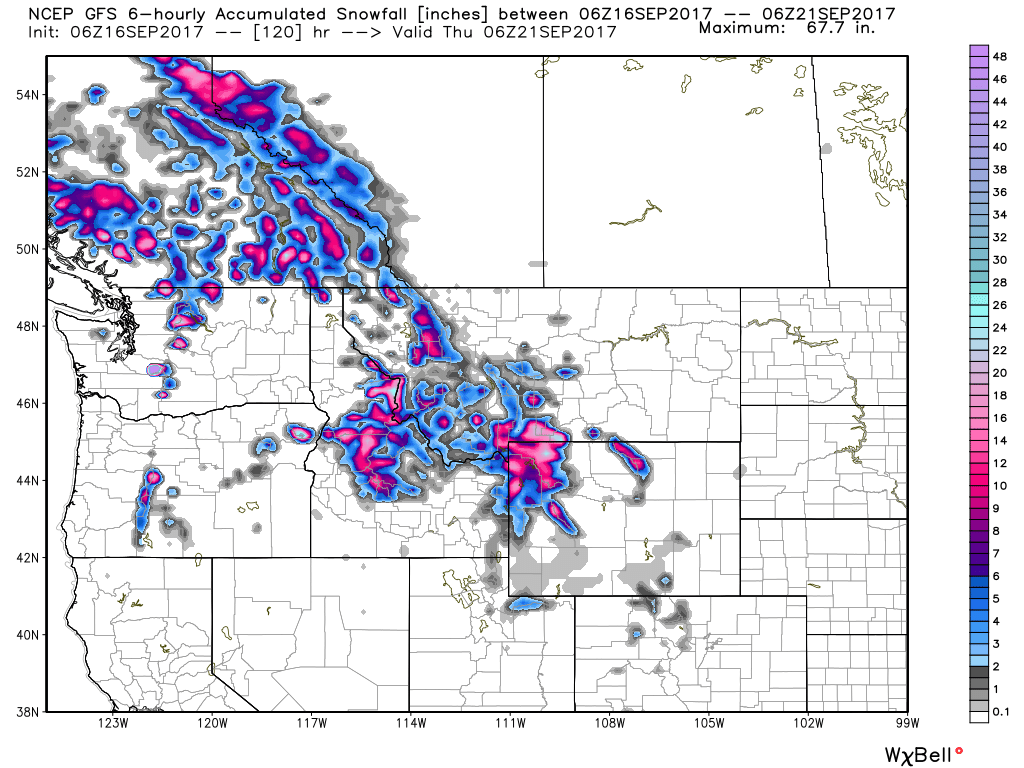

Snowfall Potential
The next system that moves into the Pacific Northwest will bring another round of moisture and cold air, which will turn over to snow in the higher elevations. Here's the snowfall potential through Wednesday night, which shows up to 6"+ snowfall potential in the mountains... And so it begins!

________________________________________________________________________
Whiff of Autumn Sunday - "Jose" May Get Loopy
By Paul Douglas
By Paul Douglas
If there is any doubt you live in the Super Bowl of Weather, the Red Zone of Meteorology, consider this. On September 15, 1916 St. Paul recorded it's earliest snowfall. On the same day 26 years later, September 15, 1939, Minneapolis registered a record high of 98F. How is that even possible? Minnesota extremes are not for the faint of heart.
September is prime time for foggy mornings and raging hurricanes. Mercifully we only have to worry about the former, as longer nights give temperatures more time to cool to the dew point, sparking lazy clouds, or fog.
Saturday's thundery front pushes east Sunday, leaving us with sunny spells, a drying breeze and upper 60s - a fine fall day. A stray shower Wednesday gives way to more numerous T-storms Wednesday.
Models suggest a late-week warming trend with another sloppy, potentially stormy frontal passage next weekend. Naturally.
No whining please. ECMWF (European) guidance shows Hurricane Jose coming close to New England Wednesday before veering out to sea, doing one big loop, maybe coming ashore near New Jersey on September 25.
________________________________________________________________________
Extended Forecast
SUNDAY: Partly sunny with a cool breeze. Winds: NW 7-12. High: 69
SUNDAY NIGHT: Partly cloudy and quiet. Winds: WNW 5. Low: 54
MONDAY: Unsettled, passing shower possible. Winds: SE 7-12. High: 66.
TUESDAY: Intervals of sun and milder. Winds: SE 8-13. Wake-up: 56. High: 75.
WEDNESDAY: Showers likely, possible T-storms. Winds: NW 8-13. Wake-up: 62. High: 74
THURSDAY: Partly sunny, a break from puddles. Winds: SE 7-12. Wake-up: 56. High: 77.
FRIDAY: Warm, sticky and summerlike. Winds: S 10-20. Wake-up: 63. High: 81
SATURDAY: What else? Showers and T-storms. Winds: SW 10-15. Wake-up: 64. High: 74.
_______________________________________________________
MONDAY: Unsettled, passing shower possible. Winds: SE 7-12. High: 66.
TUESDAY: Intervals of sun and milder. Winds: SE 8-13. Wake-up: 56. High: 75.
WEDNESDAY: Showers likely, possible T-storms. Winds: NW 8-13. Wake-up: 62. High: 74
THURSDAY: Partly sunny, a break from puddles. Winds: SE 7-12. Wake-up: 56. High: 77.
FRIDAY: Warm, sticky and summerlike. Winds: S 10-20. Wake-up: 63. High: 81
SATURDAY: What else? Showers and T-storms. Winds: SW 10-15. Wake-up: 64. High: 74.
_______________________________________________________
This Day in Weather History
September 17th
September 17th
1955: A late-season tornado hits Koochiching County. Most damage is confined to trees.
1911: Pipestone is hit with baseball-sized hail that smashes numerous windows at the Calumet Hotel and high school. The local observer measures hail three inches deep. People get their photos taken in automobiles surrounded by the icy white ground.
________________________________________________________
________________________________________________________
Average High/Low for Minneapolis
September 17th
September 17th
Average High: 71F (Record: 96F set in 1895)
Average Low: 52F (Record: 34F set in 1943)
Average Low: 52F (Record: 34F set in 1943)
Record Rainfall: 2.37" set in 2015
_________________________________________________________
_________________________________________________________
Sunrise/Sunset Times for Minneapolis
September 17th
September 17th
Sunrise: 6:54am
Sunset: 7:19pm
Sunset: 7:19pm
Hours of Daylight: 12hours & 25mins
Daylight LOST since yesterday: ~3 minutes and 5 seconds
Daylight LOST since summer solstice (June 20th): 3 hours & 12 minutes
__________________________________________________________
Daylight LOST since summer solstice (June 20th): 3 hours & 12 minutes
__________________________________________________________
Moon Phase for September 17th at Midnight
1.9 Days Before New Moon
1.9 Days Before New Moon

_________________________
Weather Outlook For Sunday
Temperatures on Sunday will be MUCH cooler than it has been over the last several days. In fact, we'll be nearly 25F cooler across the southern half of the state then we were on Thursday, when the mercury topped out at 91F in the Twin Cities (the warmest day since July 22nd when we hit 91F). Also note that dewpoints will be much cooler post cold front. In fact, dewpoints will be nearly 20F cooler than they were on Sunday. Keep in mind that for every 20F dewpoint drop, there is half as much water in the air as there was before, so it'll feel pretty good on Sunday!

Weather Outlook For Sunday
Winds will be out of the west on Sunday in the wake of the cold front that helped to produce showers and storms across the region on Saturday. Winds don't look to be too big of an issue, but there could be some 20mph+ gusts across far northwestern Minnesota.

Much of the unsettled weather that moved through Friday and Saturday will push east on Sunday. There may be a few lingering clouds, but Sunday will be the driest and brightest day of the weekend. Enjoy!
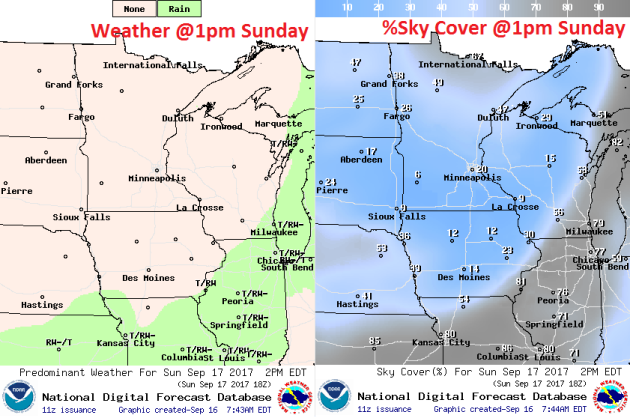
The UV Index for Wednesday will be HIGH, which means that it will only 20 to 30 minutes or less to burn unprotected skin. With that said, if you are planning on spending any extended length of time outside, make sure you wear appropriate attire and lather on the sun block!
Simulated Radar Ahead...
Here's the simulated radar across the Upper Midwest as we head into the early part of the week, which shows quiet weather on Sunday as a bubble of high pressure slides through the region. However, it doesn't take long for our next chance of rain to slide in, which looks like it could bring us a little rain on Monday before clearing a bit again on Tuesday.
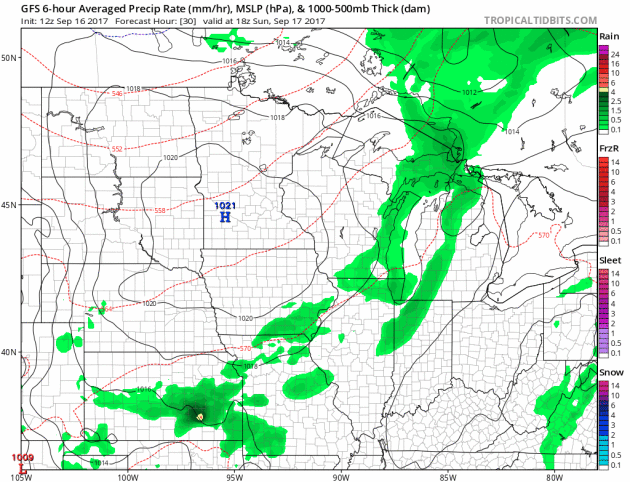
Rainfall Potential Ahead
Here's the rainfall potential across the state as we head through Thursday. Note that things could stay fairly active with fairly decent rainfall tallies possible across much of the state. There will be several rain chances with some locations seeing as much as 1" to 2" this week!
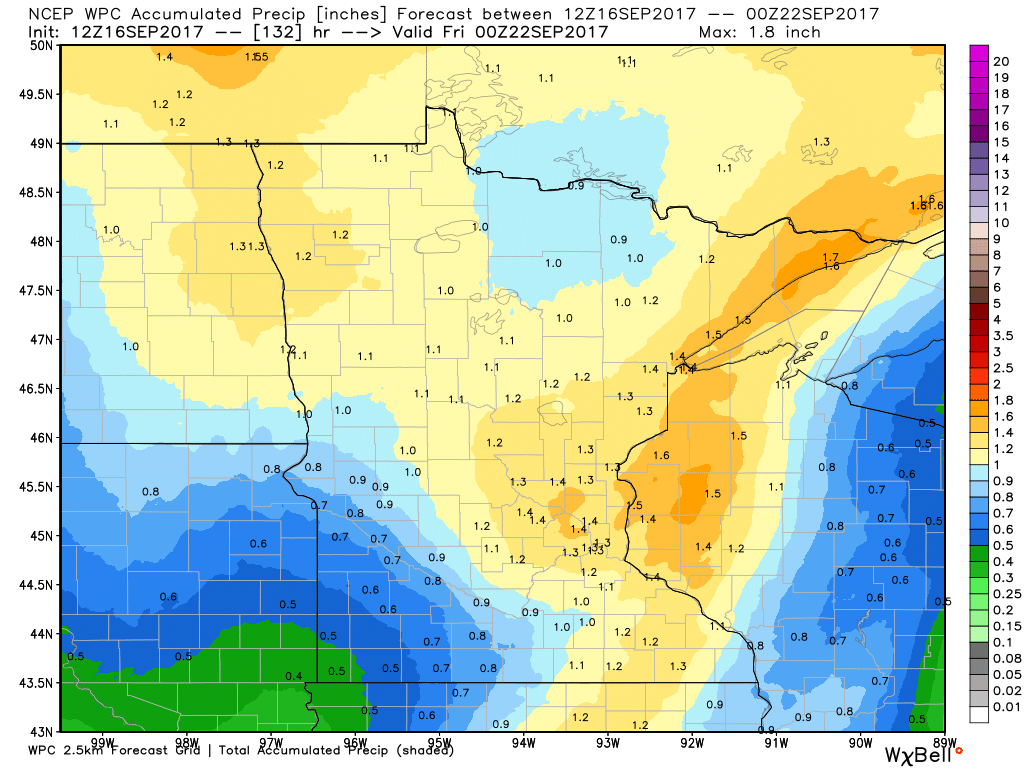
______________________________________________________
Pollen Forecast
Itchy, sneezy? I tend to get a little more allergic as we head through September until the first frosts of the season start to arrive. With that said, according to pollen.com, the allergy forecast for Minneapolis suggests low to low-medium levels over the next few days thanks to several rain chances this week. AHHH-CHOOO!!!
Minneapolis Temperature Outlook
Here's the temperature outlook through October 1st, which shows temps dipping a bit on Sunday and Monday behind a cold front, but should be able to warm back into the upper 70s/lower 80s through the week ahead. Enjoy it because the extended forecast suggests temps falling back into the 60s by the last week of the month. Note that the average high in the Twin Cities on September 30th is 65F with an average overnight low of 46F.

6 to 14 Day Temperature Outlook
According to NOAA's CPC, the extended temperature outlook from September 25th through the 29th suggests warmer than average temperatures will still linger across parts of the Midwest, but will likely start shifting into the Great Lakes as cooler than average temps continue to build in across the High Plains and western Dakotas.
___________________________________________________________
Extended Temperature Outlook
According to NOAA's CPC, the extended temperature outlook through September 29th shows that a good chunk of the Eastern and Southern U.S. will be warmer than average, but the Western US will remain cooler than average.
"Yes, climate change made Harvey and Irma worse"
"The right time to talk climate change is now. It might seem premature when people in the Caribbean, Florida and Texas are still mucking out their flooded homes. And no, changes in our planet's atmosphere did not cause Hurricanes Harvey or Irma. But the consensus among scientists is that the effects of climate change, such as rising sea levels and warmer oceans, made those storms far more destructive than they would have been in previous decades. "The short version is, climate change makes these very bad storms worse," said Sean Sublette, a meteorologist with Climate Central, a nonprofit group that studies climate change. "It's not the approximate cause of the storm, but it makes these bad storms worse. And in the case of a really bad storm, climate change can make it totally disastrous or catastrophic."The data on how our warming planet specifically impacted Harvey and Irma won't be known for quite some time. It can take months and even years to collect and analyze that information."
Impressive IRMA Stats
Thanks to Philip Klotzbach who is a meteorologist at CSU specializing in Atlantic basin seasonal hurricane forecasts for putting together these records from Hurricane IRMA... WOW - there certainly are a lot of them! Take a look: Hurricane Irma Meteorological Records/Notable Facts Recap Intensity/Day Measures
Hurricane Irma Meteorological Records/Notable Facts Recap Intensity/Day Measures
- 185 mph lifetime max winds – tied with Florida Keys (1935), Gilbert (1988) and Wilma (2005) for second strongest max winds of all time in Atlantic hurricane. Allen had max winds of 190 mph in 1980
- 185 mph lifetime max winds – the strongest storm to exist in the Atlantic Ocean outside of the Caribbean and Gulf of Mexico on record
- 185 mph max winds for 37 hours – the longest any cyclone around the globe has maintained that intensity on record. The previous record was Haiyan in the NW Pacific at 24 hours
- 914 mb lifetime minimum central pressure – lowest since Dean (2007) and 10th lowest in satellite era (since 1966)
- 914 mb lifetime minimum central pressure – lowest pressure by an Atlantic hurricane outside of the western Caribbean and Gulf of Mexico on record
- First Category 5 hurricane in the Atlantic since Matthew (2016) and first Category 5 hurricane in the tropical Atlantic (7.5-20°N, 60-20°W) since Hugo (1989)
- 3.25 day lifetime as a Category 5 hurricane – tied with Cuba (1932) for longest lifetime as Category 5
- 3 consecutive days as a Category 5 hurricane – the longest in the satellite era (since 1966)
- 12.75 named storm days – the most since Nicole (2016) and tied for 23rd most in satellite era
- 11.25 hurricane days – the most since Ivan (2004) and tied for 9th most in satellite era (since 1966) – satellite-era record is Ginger (1971) with a whopping 19.5 hurricane days
- 8.50 major hurricane days – the 2 nd most in satellite era (since 1966) – trailing Ivan (2004).
- 3.75 major hurricane days in the tropical Atlantic (7.5-20°N, 60-20°W) – trailing only Luis (1995) for major hurricane days in the tropical Atlantic
ACE Measures
- Generated the most Accumulated Cyclone Energy by a tropical cyclone on record in the tropical Atlantic (7.5-20°N, 60-20°W)
- Generated more Accumulated Cyclone Energy than the first eight named storms of the Atlantic hurricane season (Arlene-Harvey) combined
- Generated the most Accumulated Cyclone Energy in a 24-hour period on record, breaking old record set by Allen (1980)
- 67.5 Accumulated Cyclone Energy – the 2nd most by an Atlantic hurricane in satellite era (since 1966) – trailing only Ivan (70.4)
- Generated enough Accumulated Cyclone Energy to satisfy NOAA ACE definition for an average Atlantic hurricane season
- Generated more Accumulated Cyclone Energy than 18 entire Atlantic hurricane seasons in the satellite era (since 1966)
Landfall Records
- Leeward Islands: Strongest storm on record to impact the Leeward Islands defined as 15-19°N, 65-60°W for this calculation, with max winds of 185 mph. Okeechobee Hurricane (1928) and David (1979) were previous strongest at 160 mph
- Turks and Caicos: Closest approach of a Category 5 hurricane on record
- The Bahamas: First Category 5 hurricane to make landfall since Andrew (1992)
- Cuba: 160 mph, 924 mb – Category 5 - First Category 5 hurricane to make landfall since the Cuba Hurricane of 1924
- Turks and Caicos: Closest approach of a Category 5 hurricane on record
- The Bahamas: First Category 5 hurricane to make landfall since Andrew (1992)
- Cuba: 160 mph, 924 mb – Category 5 - First Category 5 hurricane to make landfall since the Cuba Hurricane of 1924
- Continental United States: 1 st Landfall (Cudjoe Key, FL): 130 mph, 929 mb – Category 4
- First Category 4 hurricane to make landfall in Florida since Charley (2004) and major hurricane to make landfall in Florida since Wilma (2005)
- 929 mb pressure is tied for 7th lowest on record for U.S. landfall with Lake Okeechobee Hurricane of 1928 2 nd Landfall (Marco Island, FL): 115 mph, 940 mb – Category 3
- Exact same latitude/longitude as well as same Saffir/Simpson Category at landfall as Wilma (2005): 25.9°N, 81.7°W
______________________________________________________________
- First Category 4 hurricane to make landfall in Florida since Charley (2004) and major hurricane to make landfall in Florida since Wilma (2005)
- 929 mb pressure is tied for 7th lowest on record for U.S. landfall with Lake Okeechobee Hurricane of 1928 2 nd Landfall (Marco Island, FL): 115 mph, 940 mb – Category 3
- Exact same latitude/longitude as well as same Saffir/Simpson Category at landfall as Wilma (2005): 25.9°N, 81.7°W
______________________________________________________________
IRMA's Track
Irma was an interesting storm as it started as a wave of energy off the west coast of Africa that quickly became a tropical storm just a few days later. 6 days after turning into a tropical storm, it was a category 5 hurricane! It then moved through the Caribbean and eventually made landfall with southern Florida on September 10th.
___________________________________________________________
"Environmentalists get win in US coal-climate change lawsuit"
"Handing a major victory to environmentalists, a court cast doubt Friday on a longstanding U.S. government argument that blocking federal coal leasing won't affect climate change because the coal could simply be mined elsewhere. Environmentalists have been trying for years to block federal coal leases on climate-change grounds with limited success. The ruling by the 10th U.S. Circuit Court of Appeals will require the U.S. Bureau of Land Management to provide more data to support its argument that coal makes no net contribution to climate change after it's burned in power plants. The BLM oversees leasing of vast Western tracts that supply much of the nation's coal. "This is big. And we're certainly going to be wielding this and using it to confront other mining approvals both in the Powder River Basin and beyond," said Jeremy Nichols with WildEarth Guardians. The Sierra Club and WildEarth Guardians sued to block four leases that would allow mining to continue at the Black Thunder and North Antelope Rochelle mine, the two biggest in the U.S. by production. Both are in the Powder River Basin, where vast, open-pit mines supply around 40 percent of the nation's coal."
(Image credit: Associated Press Via ABCNews)
"Sachs: Big Oil will have to pay up, like Big Tobacco"
"Here is a message to investors in the oil industry, whether pension and insurance funds, university endowments, hedge funds or other asset managers: Your investments are going to sour. The growing devastation caused by climate change, as seen this month in Texas, Florida and the Caribbean, are going to blow a hole in your fossil-fuel portfolio. Not only will the companies you own suffer as society begins to abandon fossil fuels in earnest, they will also be dragged through the courts here and abroad for their long-standing malfeasance and denial of what they have done to the world.
Climate change deniers, mainly politicians in the pay of the oil industry, protest that there is no proof that destructive storms and floods are the result of human-induced global warming. Who can say that a Hurricane Harvey or Irma wouldn't have occurred in the past?"
Climate change deniers, mainly politicians in the pay of the oil industry, protest that there is no proof that destructive storms and floods are the result of human-induced global warming. Who can say that a Hurricane Harvey or Irma wouldn't have occurred in the past?"
(Image Credit: NOAA)
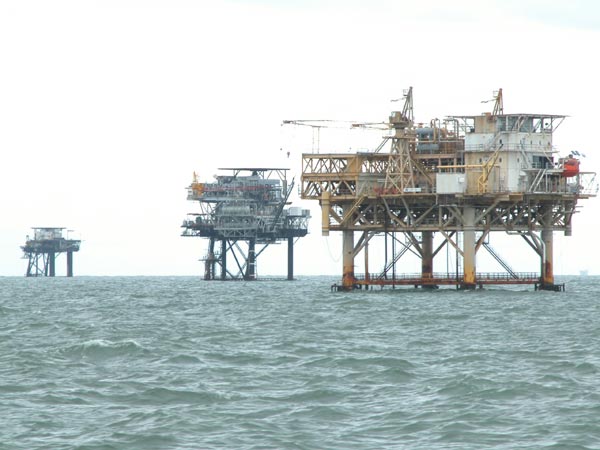
__________________________________________________________
Thanks for checking in and don't forget to follow me on Twitter @TNelsonWX

No comments:
Post a Comment